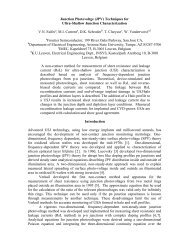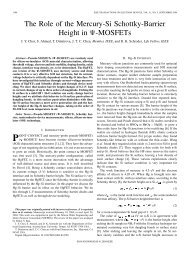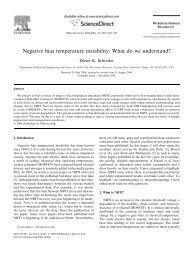ECS Transactions 3, (4), 321-337 (2006) - Dieter Schroder - Arizona ...
ECS Transactions 3, (4), 321-337 (2006) - Dieter Schroder - Arizona ...
ECS Transactions 3, (4), 321-337 (2006) - Dieter Schroder - Arizona ...
You also want an ePaper? Increase the reach of your titles
YUMPU automatically turns print PDFs into web optimized ePapers that Google loves.
<strong>ECS</strong> <strong>Transactions</strong> 3, (4), <strong>321</strong>-<strong>337</strong> (<strong>2006</strong>)<br />
temperature near the drain-gate region of AlGaN/GaN power HFETs on sapphire and SiC<br />
substrates. 33 The higher thermal conductivity of SiC clearly lowers the local device temperature<br />
and Raman allows such measurements to be made at high spatial resolution.<br />
Raman Intensity (a.u.)<br />
12<br />
10<br />
8<br />
6<br />
4<br />
2<br />
T=95 o C<br />
0<br />
510 520<br />
Raman Shift (cm -1 )<br />
Figure 15. MOSFET at T = 25 o C and 95 o C. The 95 o C peak is broadened and shifted to<br />
lower energies. Adapted from ref. 32.<br />
∆T (K)<br />
334<br />
T=25 o C<br />
30<br />
200<br />
Si<br />
25<br />
S<br />
On<br />
G<br />
150<br />
20<br />
D<br />
sapphire<br />
0 x<br />
15<br />
100<br />
On SiC<br />
10 L=0.6 mm<br />
V<br />
5 D<br />
=V G<br />
=6 V<br />
50<br />
I D<br />
=4.14 mA<br />
AlGaN/GaN<br />
0<br />
0<br />
0 5 10 15<br />
0 0.5 1 1.5 2<br />
x (µm)<br />
Power Dissipation (W)<br />
Figure 16. (a) Temperature change profile along the Si MOSFET width direction (from<br />
ref. 32), (b) temperature versus power dissipation in the drain-gate region in AlGaN/GaN<br />
power HFETs (from ref. 33).<br />
Spectroscopic Ellipsometry (SE), a contactless, non-invasive technique measures changes<br />
in the polarization state of light reflected from a surface. One determines the complex<br />
reflection coefficient ratio ρ which is dependent on the ratio of the complex reflection<br />
coefficient for light polarized parallel (R p ) and perpendicular (R s<br />
) to the plane of incidence.<br />
Spectroscopic ellipsometric measurements have extended the range of conventional<br />
ellipsometry by using more than one wavelength. 34 Furthermore, it is possible to<br />
vary not only the wavelength but also the angle of incidence, providing yet another degree<br />
of freedom. The ellipsometer is sensitive to surface changes on the order of a<br />
monolayer. Film thickness and alloy composition can be determined during growth or<br />
during etch. Optical measurements are ideal for real-time measurements because they are<br />
non-invasive and can be used in any transparent ambient including ambients associated,<br />
for example, with plasma processing and chemical vapor deposition.<br />
Film Thickness Spectroscopic ellipsometry is one of few techniques allowing measurements<br />
of Si films of SOI wafers. Si films as thin as 10 nm can be reliably measured, as<br />
shown in Fig. 17, where strained Si on insulator (sSOI) substrates are fabricated by bond-<br />
Temperature (K)








